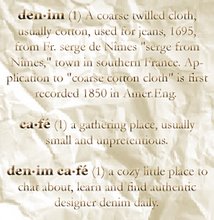
No, I'm not talking about those things oxen wear to plow the fields or pull your wagon to Oregon, or the center of your yummy sunny-side up on your breakfast plate. This is the v-line at the back of your jeans. The one no one really talks about or is quite sure what it's function is. In fact, even Google wasn't so certain when I asked it.
So what is the yoke there for? Its main function is to aid in proper assembly of the leg area to the waist area. Picture it as you would a doll, it is seperated into many parts to allow for better movement and appearance. The yoke allows for the waist to have its chosen 'contour', ie tighter or wider at the waist. Without the yoke, it is much more difficult to make a pair of jeans that will not bunch or scrunch in odd areas (but it is still done from time to time, especially for trouser style pants and jeans).
Aside from the technical aspects, a yoke can have a very appealing and aesthetic effect for your derriere. Picture now an empire dress, which has a line just below the bust, seperating it from the length of your torso. This has a very flattering and 'lifting' effect. This is essentially what is going on back there on the yoke! The yoke's shape (a nice u or v) will help make your rear more balanced and perky due to the lines adding seperation as well as vectors that draw your eye upwards. This is why you will always hear people suggesting to look for jeans with a yoke, and avoid one's that don't have one (since they make your rear look bigger and less toned).
What about those funky yokes like the Farmer designer brand jeans for instance? These still have the same ability to add balance and perkiness, because the yoke still draws your eye upwards. Sometimes jeans have different shape yokes that can make your hips, waist, or rear seem wider. Other times it can make your rear seem flatter or rounder. Yokes that are placed closer to the waist (higher on the rear) will naturally make your rear look higher, as long as the pockets are placed well. Yokes that are lower on the rear, being closer to 'center' in the back will have a very balancing effect. Some of the largest yokes I've seen are on True Religion's Big (and Super) T Sammy's. They are so big and center that there is honestly no need for pockets, but they are there anyways, and still look great on!
When you are buying trousers, it is more recommended to find trousers with yokes than without. Sometimes you can get the 'hanging off your rear' look instead of a well fitted pant without a yoke. If there's none in sight, atleast aim for pockets that substitute for the vector lines that yokes create (ie, pockets that are horizontal lines, and closer to the center of the rear if possible).
The yoke shape and size also allows designers to play with perceptual illusions that, if used correctly, can actually enhance your derriere! Take a look at the model below to better understand what each yoke shape and size does best.

Inverted Arc: Gives the illusion of a fuller rear.
Straight (Horizontal): This yoke line will make your waist appear wider. I wouldn’t recommend it if you wish to emphasize curves
“V” Shape: Most widely used and most flattering back yoke cut.
Sweet Heart: This yoke type can truly enhance a small derrière, as the cut is clearly outlining a curvy heart shape. It works very well with stretch tight jeans since it allows the pants to conform to your figure.
Extra Wide: This cut is used to achieve the “falling pants” look. The illusion is enhanced by the placement of the pockets way below the but. This look is great for some guys, though not very flattering to any woman’s figure. It beats having the pants actually falling, and certainly makes a point: illusions work!
No Yoke: Of course, this option exists, and is usually combined with seamed pockets. The garment is contoured by the use of darts. This look is very conservative, and with a proper fit can work very well for women with large rear ends.
-yoke chart and types cited from www.jeans-and-accesories.com
So now that you know what that little yoke is there for, next time you try on a pair of jeans, check out what the yoke is doing (or not doing) for you!





No comments:
Post a Comment